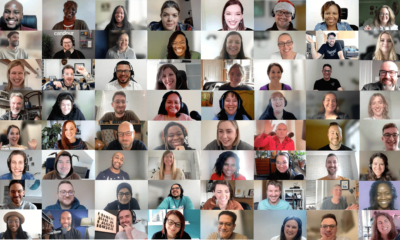MARKETING
How to Gain More Customers Online


Image sourced from Startup Bonsai
You already know how powerful social media and social media platforms are. After all, there are billions of people using them, around 4.59 billion in 2022 and that number is expected to grow to 5.85 billion by 2027. That’s the majority of the world’s population within reach of any and all of your marketing efforts.
Your customers read your social media posts, and they also read posts and reviews that discuss your brand and your products. But how do you turn those connections into actual leads? How do you use social media as an efficient lead generation tool? We look at some tips so you can maximize the leads that come to you from social media platforms.
Is social media important to your business?

Image sourced from Smart Insights
The simple answer to that is ‘yes’. Even a small B2B business might look to LinkedIn to connect with existing customers and to generate leads. A bigger organization would probably be using a multi-channel approach and focusing on the platforms where most of their demographic targets would be found.
In fact, there are very few businesses who don’t recognize the importance of social media and use it to connect with people. There are many benefits from using social media, from developing your brand to carrying out market research. But what you really want to achieve when setting goals for marketing is more customers, more sales, and of course, more profit.
Social media leads are when potential customers either contact you via social media or provide contact details that indicate they want you to provide them with more info and to contact them. Which platform can supply the best leads will depend on your business type and model, but the most popular tend to be Facebook, Twitter, LinkedIn, and Instagram.
You can even use an Instagram hashtag generator to extend your reach on social media.
8 tips to increasing your leads and customers via social media
So, you know the power of social media graphics and you have already identified which platforms best suit you and are likely to provide genuine leads that your sales and marketing staff can nurture and guide through your sales funnel. How do you ensure that your social media efforts are at the top of their game and attracting as many new customers as possible?
1. Create great (and clickable) content

Free to use image sourced from Pixabay
Your content needs to be compelling and engaging and it needs to stand out from your competitors. If people find your content engaging, then it’s more likely they will want to know more about you and your products. That means content and images that are sharp, to the point, and relevant to the people reading it.
Just as importantly, you want all – or most – of your content to have clickable components. If people need to go searching for more info or for links to your site, they may simply not bother. You could use idea management software to help you organize your thoughts for new content.
If your content is about international calling services, then include a CTA (call to action) and clickable links to the product’s landing page. If a more generic post, you can still include links to your website.
2. Optimize your profiles
If your social media pages are messy and badly organized, it may not matter if you are creating great content. Ensure your profiles not only look good but contain any relevant information a customer might need such as contact info. That can include buttons to contact you by Messenger or WhatsApp, location of physical stores, and details such as email address and phone number.
Most of the social media platforms allow businesses to add ‘buttons’ to their profiles. This could be something as simple as being able to sign up for your newsletter on your Facebook page or being able to book a consultation or make a reservation. Remember, even if a platform does not have this ability, you can cross post from the platforms that do.
3. Ensure your landing pages are up to scratch

Free to use image sourced from Pixabay
It’s not just about your social media pages. They can be as glitzy and attractive as possible but if a customer clicks on a link just to find poorly-designed landing pages, then they may well become part of your bounce rate figures. The page they click to has to be relevant too; there is little point in creating a post about localization software testing then when the customer clicks on the link, they find something completely different.
Your landing page should be clear as to purpose and optimized as much as possible (think A/B testing). Keep any things such as webforms as simple as possible and ensure that the page contains any relevant info such as pricing. As with your social media posts, don’t forget a CTA that encourages customers to buy the product easily.
4. Incentivize where possible
Potential customers probably see multiple marketing posts every day. Why should they choose to click on your links? Incentives can vary greatly depending on the type of lead you want to generate. For example, if you are just looking to increase your newsletter/mailing list for future marketing campaigns, you could decide to offer a discount code when people sign up.
Contests can be a great way to spread both reach and brand awareness. By offering a prize draw when people like and share a post, your content (and thus your products) can reach far more people than might have seen it on your page. Offering discounts and other incentives can be a great tactic for increasing the number of leads generated by your social media content.

Want to get certified in Content Marketing?
Leverage the tools and channels to predictably and profitably drive awareness, leads, sales, and referrals—EVERYTHING you need to know to become a true master of digital marketing. Click Here
5. Personalization
Personalized targeting can be another helpful tactic when it comes to social media lead generation. You are likely already using some level of personalization in your marketing efforts, so why not extend that to social media too.
Some platforms offer targeting tools so that you can reach your ideal demographic targets. You can also segment those targets according to various factors such as location, gender, or age. If you are marketing online phone numbers from Dialpad, then targeting businesses directly that will have an interest in that service is more likely to generate high-quality leads.
6. Don’t forget retargeting
There can be many reasons why a customer does not make an immediate decision to buy from you. It could be a budgetary reason or they simply want to take some time to compare brands and products. However, these are still people who have shown some level of interest in your brand and/or products so they are worth thinking about when it comes to your social media content.
Some platforms allow you to access detailed info about a user who has engaged with you. This means you can customize and personalize those users who have previously shown interest. It provides good ROI too as retargeted customers are 70% more likely to convert than people seeing some of your content for the first time.
7. Data, data, data

Free to use image sourced from Pixabay
If you embark on a new strategy of Twitter, Instagram, or TikTok lead generation then, of course, you want to know how successful your tactics are. That means you need to collect all relevant data and see what the analytics tells you about the leads generated. Were they of high quality? Did they lead to conversions? Having those answers tells you if you need to change anything.
Even using Google Analytics, you can track where any leads came from. It will highlight which social media platforms are working best for you and if you need to put extra work into those that are not performing well. You can also use social analytics tools to see what sort of content, images, and even video are working best for you, engaging with customers, and creating leads.
8. Try using social lead ads
Ok, everyone loves organic lead generation, especially your CFO, but there may come a point when organic sources slow down or even dry up altogether. All platforms offer some form of paid ads that can help increase your lead generation rate. You may not want to do so on all the platforms you utilize but it is a strategy worth exploring.
Again, follow the data and let your analytics show what ads are working on what platforms and try to engage with your audience through comments, make sure to hide comments on facebook that are irrelevant or spoil the brand image. It is likely that you need to create different content for each ad (just as you may have done for different segments of your audience), so pay careful attention to what people are liking and what is leading to quality lead generation.
The Takeaway

Free to use image sourced from Pixabay
Lead generation is a crucial part of any marketing strategy. By generating a steady stream of new (and quality) leads, you are creating the opportunity to turn potential customers into actual customers. That could be achieved by your sales team nurturing those leads and providing the information people need to make a buying decision. It could also be achieved by a well-designed and optimized website and landing pages.
Social media is a great route to spreading awareness of your brand and generating quality leads. It’s definitely not a ‘one size fits all’ tactic and careful thought needs to go into how you will generate leads and where they will originate from. If done properly, you can see an increase in the number of leads generated and, hopefully, an upturn in your conversion rates.


















You must be logged in to post a comment Login